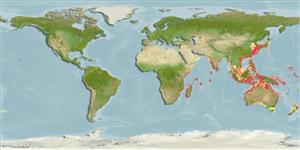Environment: milieu / climate zone / depth range / distribution range
Écologie
marin démersal; profondeur 40 - 300 m (Ref. 4313). Temperate
Indo-West Pacific: Natal, South Africa to southern Japan (Ref. 4313). Two populations apparently exists, the Western Pacific and SE African coast (Ref. 54479).
Taille / Poids / Âge
Maturity: Lm ? range ? - ? cm
Max length : 38.0 cm TL mâle / non sexé; (Ref. 90102)
Épines dorsales (Total): 13; Rayons mous dorsaux (Total): 9; Épines anales 2; Rayons mous anaux: 7 - 8. Long filaments at the tips of the dorsal fin spines and outer rays of the caudal fin (Ref. 48635).
Usually found in sheltered coastal bays and fine sand or muddy habitats. May partly bury itself in the substrate during the day and is easily overlooked. When disturbed, the brightly colored pectoral fins probably serves to startle predators. The large fins serve primarily to corner prey when hunting (Ref. 48635). Trawled on soft bottom in coastal waters (Ref. 4313), to 300 m depth (Ref. 48635).
Life cycle and mating behavior
Maturité | Reproduction | Frai | Œufs | Fécondité | Larves
Eschmeyer, W.N., 1986. Scorpaenidae. p. 463-478. In M.M. Smith and P.C. Heemstra (eds.) Smiths' sea fishes. Springer-Verlag, Berlin. (Ref. 4313)
Statut dans la liste rouge de l'IUCN (Ref. 130435)
Utilisations par l'homme
Aquarium: Commercial
Plus d'informations
Noms communsSynonymesMétabolismePrédateursÉcotoxicologieReproductionMaturitéFraiRassemblement de ponteFéconditéŒufsDéveloppement de l'œuf
RéférencesAquacultureProfil d'aquacultureSouchesGénétiqueElectrophoresesHéritabilitéPathologiesTraitementNutrientsMass conversion
CollaborateursImagesStamps, Coins Misc.SonsCiguateraVitesseType de nageSurface branchialeOtolithesCerveauxVision
Outils
Articles particuliers
Télécharger en XML
Sources Internet
Estimates based on models
Preferred temperature (Ref.
123201): 14.9 - 26.8, mean 22 °C (based on 553 cells).
Phylogenetic diversity index (Ref.
82804): PD
50 = 0.7500 [Uniqueness, from 0.5 = low to 2.0 = high].
Bayesian length-weight: a=0.01023 (0.00444 - 0.02358), b=3.01 (2.82 - 3.20), in cm total length, based on LWR estimates for this (Sub)family-body shape (Ref.
93245).
Niveau trophique (Ref.
69278): 4.0 ±0.7 se; based on size and trophs of closest relatives
Résilience (Ref.
120179): Faible, temps minimum de doublement de population : 4,5 à 14 années (Preliminary K or Fecundity.).
Fishing Vulnerability (Ref.
59153): Low to moderate vulnerability (28 of 100).
